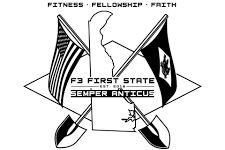7/3/2019
QIC – Ruxpin
PAX – Sugar Daddy, Chairman, Gump, Leatherman, Wild Wing
PRIMIS – Lewes, DE
Warm Up: 20 SSH IC; 20 Horseshoe Crab Flippers IC; 20 Squats IC; 20 Shoulder Taps IC; 20 Legs Raises IC.
The Thang: Mosey to the covered pavilion for 2 pain stations.
STATION 1 Pavilion: 20 Dips OYO; 20 Derkins OYO; 20 Wide Arm Merkins OYO; 20 Staggered Arm Merkins OYO (10 each hand forward).
STATION 2 Pavilion: 20 Big Boys OYO; 20 E2K each side OYO; 20 Gas Pumpers OYO; 20 Reach Through Crunches OYO.
Third F Message: Please see below.
STATION 3 Wheelhouse Parking Lot: Sprints @ 50%, 75%, 100% speed with 20 Squats after the speed set. (x2). Wosey to the draw bridge for a Bear Crawl to the top with 20 Bobby Hurleys looking out over the canal.
STATION 4 The BIKE RACK: Wosey to the Rack for 20 Pull Ups & 20 Double count Flutters. Mosey back to the courts.
Count off, Name-O-Rama, COT.
Third F Message on Dates surrounding Independence Day:
APRIL 19, 1775: The Revolutionary War begins with shots fired at Lexington and Concord in Massachusetts.
JUNE 7, 1776: Richard Henry Lee introduces a motion in a meeting of the Continental Congress that the United States IS AND SHOULD BE DECLARED free from ties to Great Britain. Delegates disagree about the wisdom of the idea, which comes to be called the “Lee Resolution”. Eventually, the Congress appoints a Committee of Five to draft a Declaration of Independence for consideration.
JUNE 11, 1776: John Adams convenes the Committee of Five to draft a Declaration of Independence. The five members of the committee are John Adams, Benjamin Franklin, Thomas Jefferson, Robert Livingston and Roger Sherman. The committee chooses Jefferson to write the first draft.
JULY 2, 1776: The Continental Congress votes to declare independence from Great Britain, formally adopting the Lee Resolution. The next day John Adams writes in a letter to his wife that, “The second day of July, 1776, will be the most memorable epocha in the history of America….It ought to be solemnized with pomp and parade, with shows, games, sports, guns, bells, bonfires, and ILLUMINATIONS, from one end of this continent to the other, from this time forward, forevermore”.
JULY 3, 1776: The Continental Congress begins debating and editing the draft Declaration, eventually making 86 edits and cutting the length by about a fourth.
JULY 4, 1776: The Continental Congress approves the final draft of the Declaration, formalizing what had already been decided on July 2. Congress hires printer John Dunlap to print copies of the Declaration to be distributed throughout the colonies.
JULY 9, 1776: A copy of the Declaration of Independence had reached New York City. With Hundreds of British Naval ships occupying New York Harbor, revolutionary spirit and military tensions were running high. George Washington, commander of the Continental forces in New York, read the document aloud in front of City Hall. A raucous crowd cheered the inspiring words, and later that day tore down a nearby statue of George III. The statue was subsequently melted down and shaped into more than 42,000 musket balls for the fledgling American Army.
